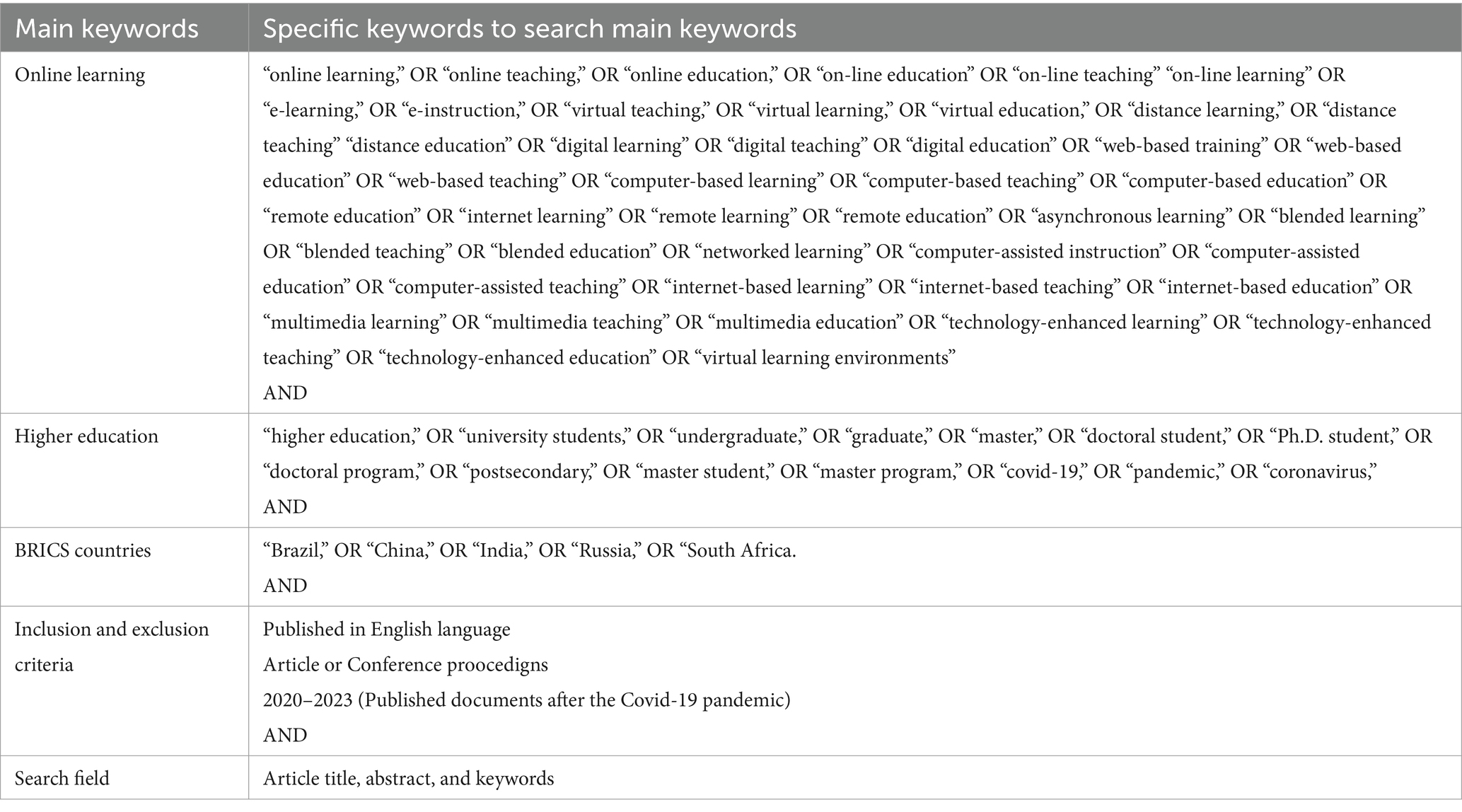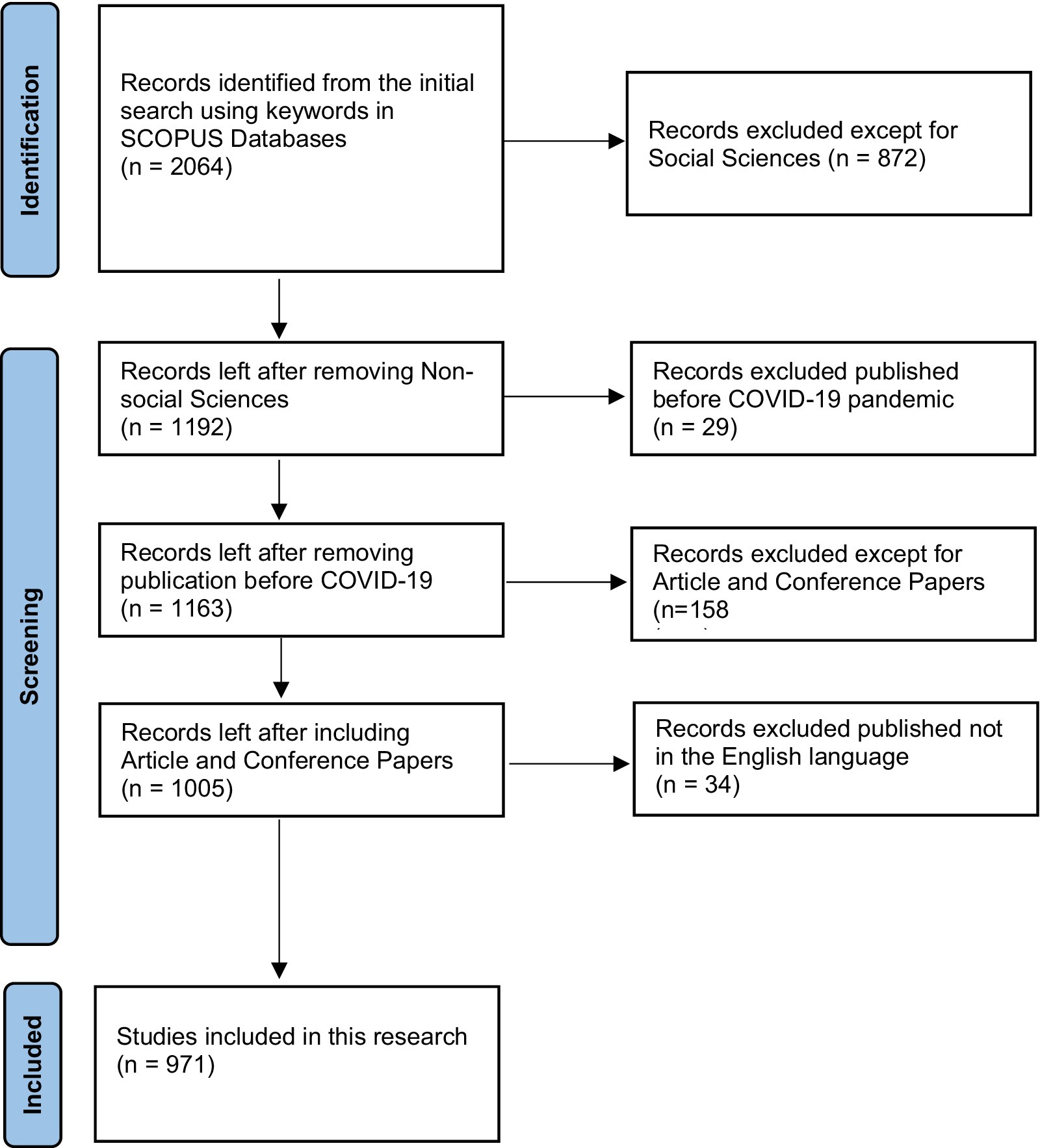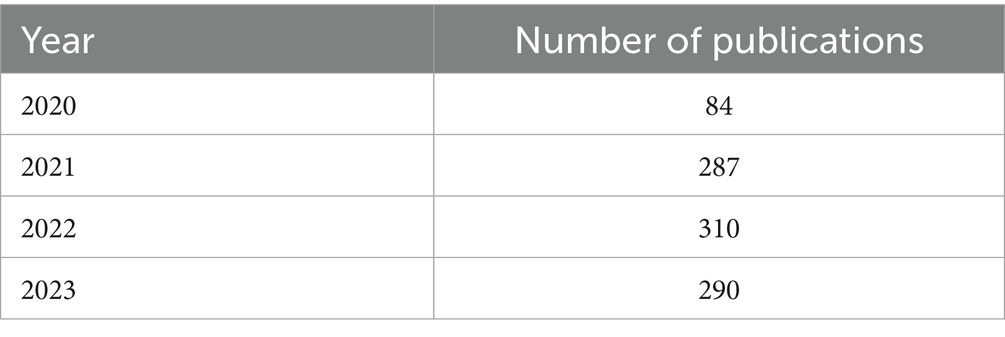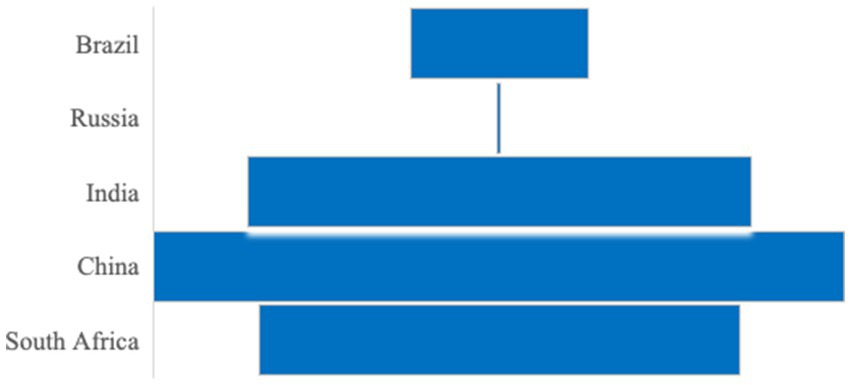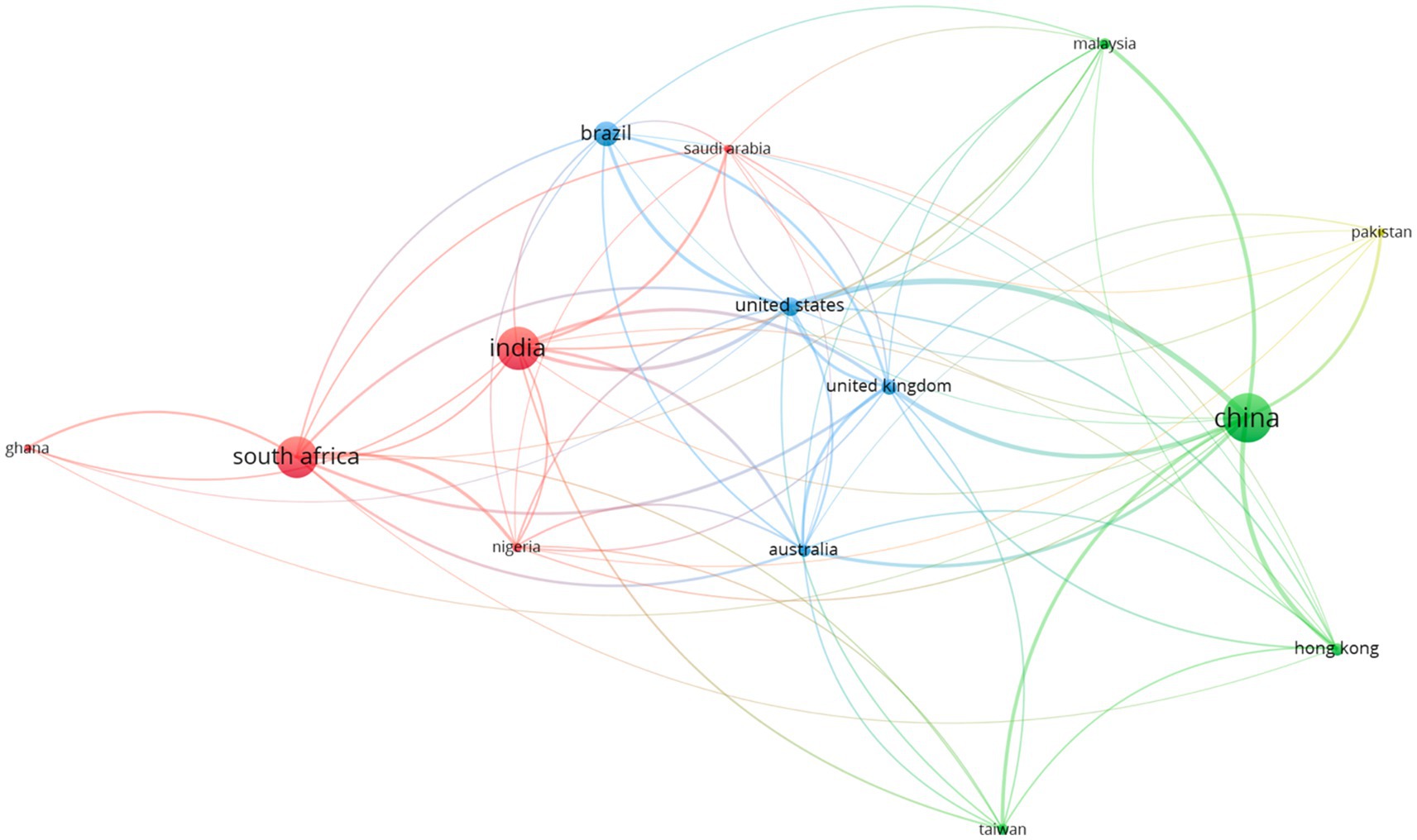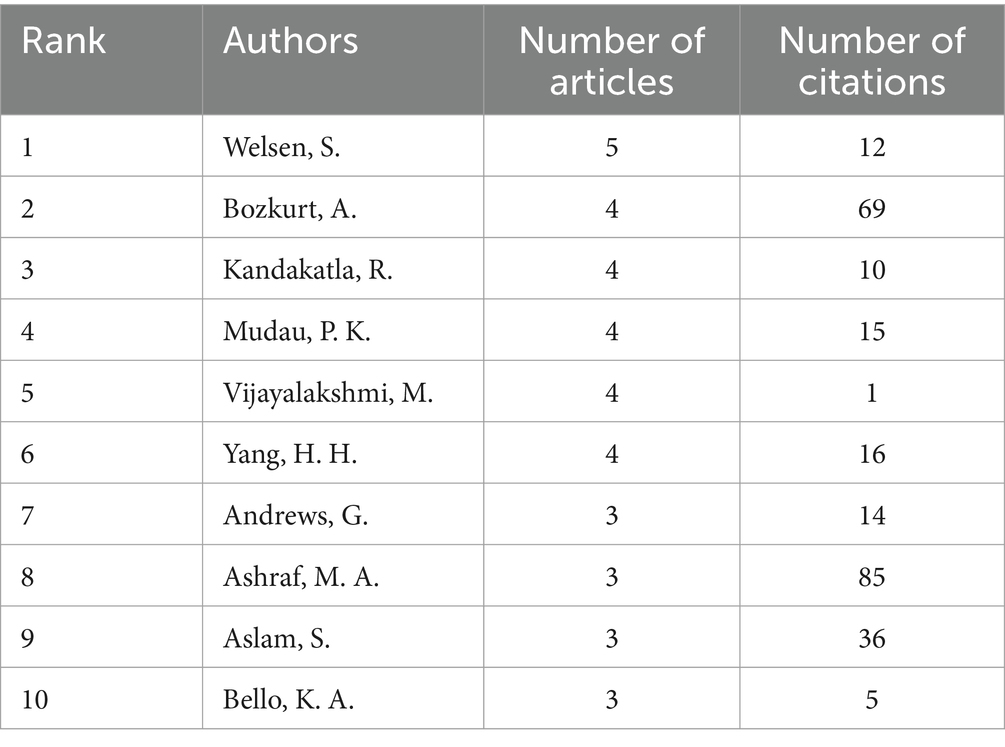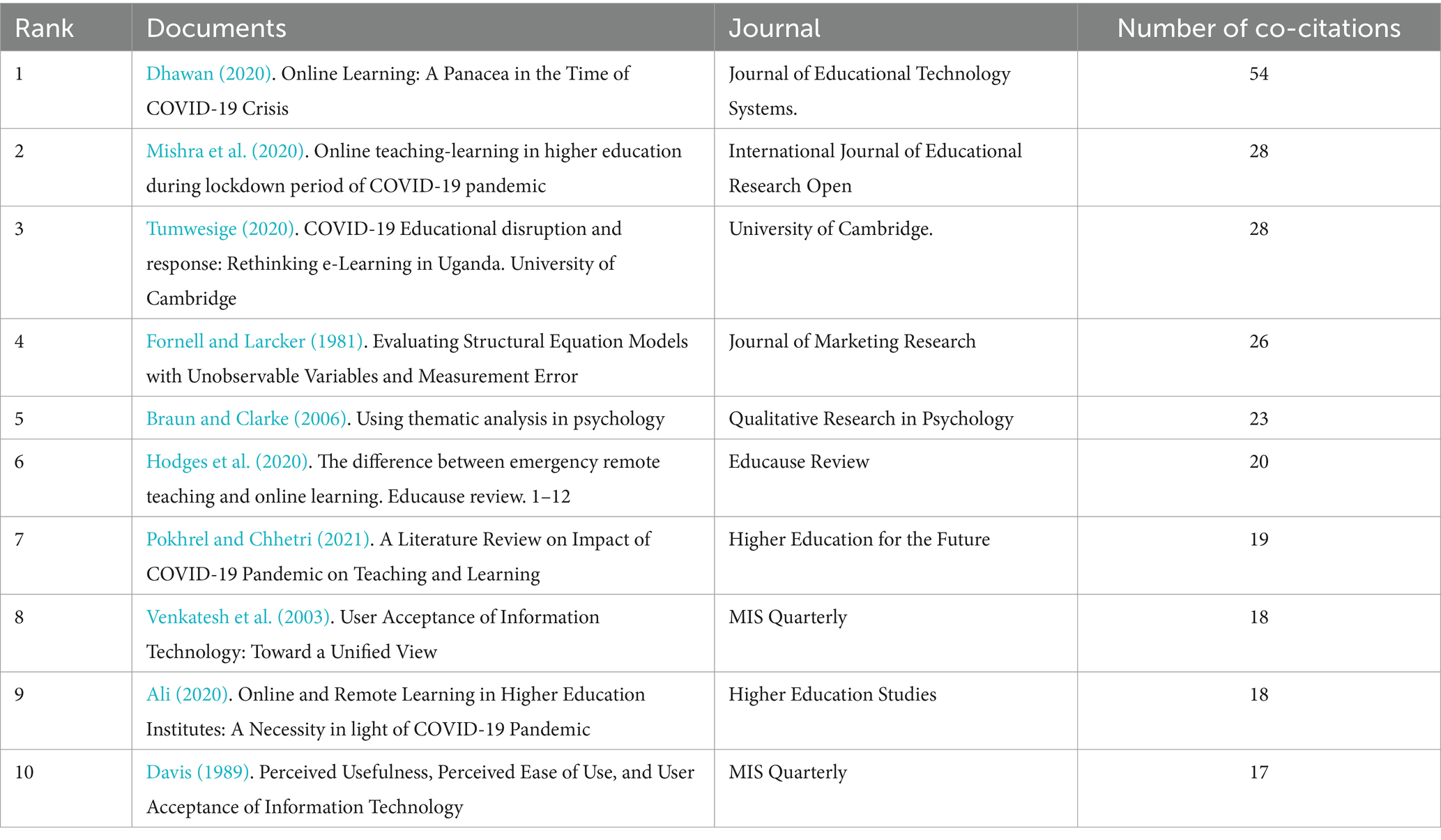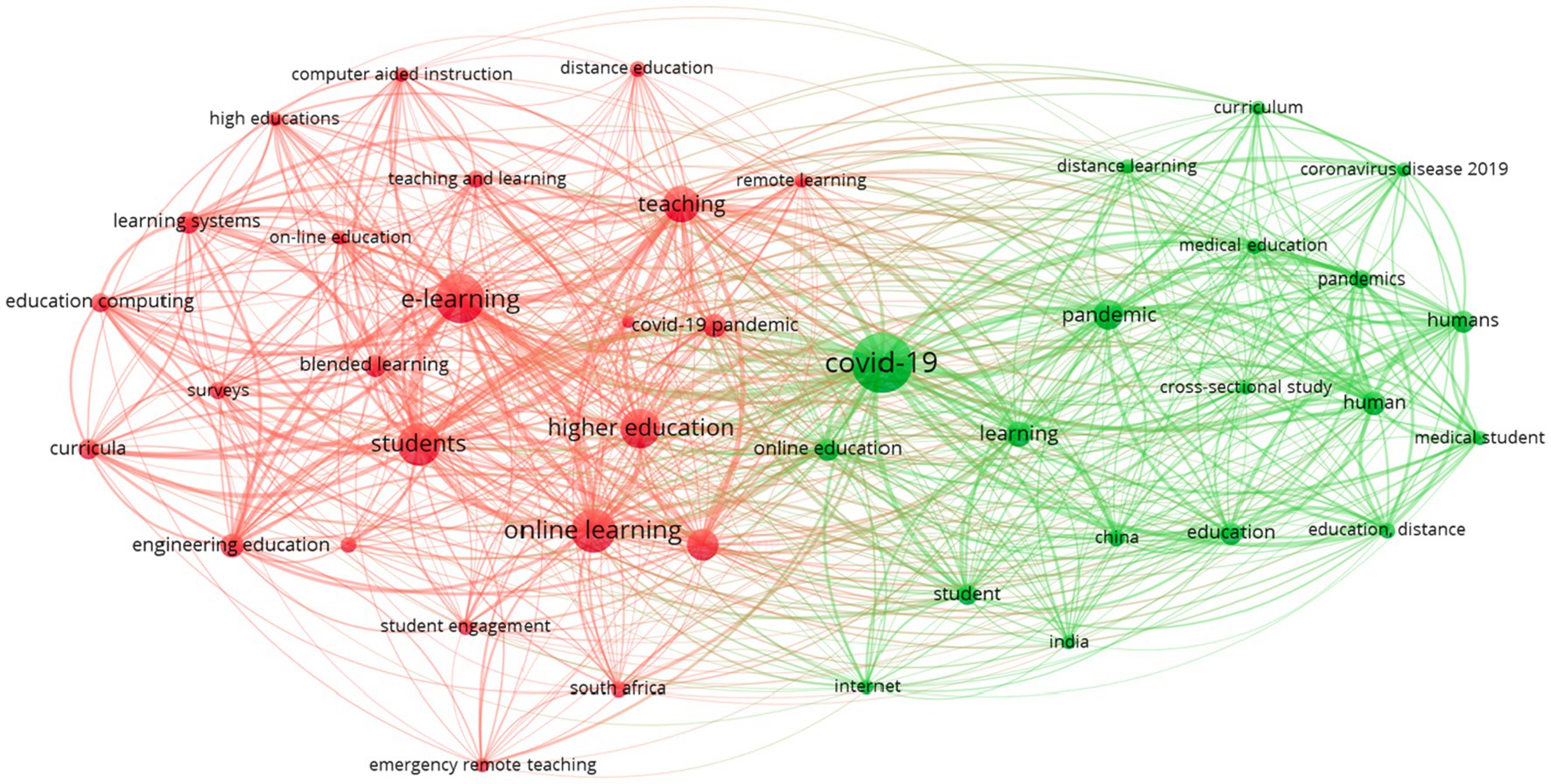- 1Department of Pedagogy of Higher Education, Kazan Federal University, Kazan, Russia
- 2Department of Humanities, Financial University Under the Government of the Russian Federation, Moscow, Russia
- 3Department of Pedagogy and Psychology, MGIMO University, Moscow, Russia
- 4Department of Foreign Languages, Peoples' Friendship University of Russia, Moscow, Russia
This paper aims to provide a holistic overview of research trends examining online learning in higher education in BRICS countries, an acronym for an association of five major emerging economies: Brazil, Russia, India, China, and South Africa, after COVID-19 using bibliometric analysis. Researchers utilized VOSviewer’s software to analyze the data using a bibliometric approach. 971 publications from the SCOPUS database were found appropriate for this research based on the inclusion and exclusion criteria. The results of the number of documents showed that there has been an increase in the amount of research on online learning in higher education in the BRICS countries. Also, the results showed that researchers from China and South Africa had the highest publications on online learning. However, researchers in Russia had very few publications. In addition, the co-authorship relationships among the BRICS countries revealed specific relationships of scholars with their colleagues from other countries. The results revealed that scholars from Indian and South African researchers had close collaborations, and Russian researchers did not have any collaborations with other countries. Finally, the results revealed two lines of research trends. The first line of research has focused on e-learning, online learning, students, and teaching. The second line of COVID-19 has focused on the pandemic, learning, online education, and students. Based on the results, recommendations are made for further research and higher education.
Introduction
Online learning has become increasingly important in higher education, particularly during the COVID-19 pandemic. The transition to online learning was essential for higher education institutions to maintain the continuity of education (Dhawan, 2020). The sudden shift to online learning due to the pandemic has presented challenges for students and highlights the importance of adaptability and understanding the impact on learning experiences (Besser and Zeigler-Hill, 2022). Research shows that online learning has emerged as an essential tool for universities to deliver education on and off campus (Shahzad et al., 2020). In response to the challenges of the pandemic, higher education institutions have had to address various aspects of online learning, such as integrating synchronous and asynchronous learning tools, ensuring technology access, and enhancing faculty and student online skills (Turnbull et al., 2021). Online learning has been crucial in enhancing the efficacy of education during the pandemic by offering students flexibility in terms of time and location (Li and Pei, 2023). Efforts have been made to promote online learning, with initiatives in developing countries (Yang et al., 2022). Quality assurance in online learning programs is crucial to ensure quality education in higher education (Hafeez et al., 2022). Online learning has become indispensable in higher education because it allows students to engage with course content, interact with instructors, and access educational resources conveniently (Zhu, 2021). The future of higher education is increasingly intertwined with online learning, which offers flexibility and accessibility to learners.
In the wake of the COVID-19 pandemic, online learning in higher education has faced issues such as the lack of interaction in virtual classrooms, inefficient use of internet technology, and limited ICT resources (Ozdamli and Karagozlu, 2022). Students and educators had to quickly adapt to online platforms, which raised concerns about the organization and delivery of online learning (Ali, 2020). The transition to online learning presented challenges regarding students’ ability to adapt to online learning environments, known as online learning skills, which became essential during the pandemic (Koh et al., 2023). In addition, the global closure of educational institutions and the shift to online platforms due to the pandemic significantly impacted student engagement and academic resilience (Sartika and Nirbita, 2023). Although student satisfaction with online education increased in certain regions, challenges persisted, including unstable network signals, a lack of educational resources, and challenges in assessing educational quality (Mazurek, 2022; Zhang and Wu, 2022). The lack of face-to-face meetings and the transition to distance learning affected student satisfaction and engagement in online education. In addition, the COVID-19 outbreak accelerated the integration of digital technologies into education, but challenges such as limited practice opportunities, pedagogical deficiencies, and mental well-being issues also emerged (Mustapha et al., 2021; Ozdamli and Karagozlu, 2022). The pandemic also led to a reassessment of teaching methods and a shift to blended or hybrid forms of digital learning, which were expected after COVID-19 (Guppy et al., 2022). The sudden shift to distance learning during the emergency underscored the need for institutional capabilities to support students in designing online classrooms (Riddell et al., 2021; Morton and Durandt, 2023).
The significance of educational technologies in the shift from face-to-face to online teaching during the pandemic was underscored (Turnbull et al., 2021). The sudden shift to online instruction due to the pandemic resulted in extensive disruptions to higher education, underscoring its adverse effects (Ardissone et al., 2023). An analysis of research reports and case studies emphasized key issues in teaching and learning arising from the pandemic, focusing on activities in North American higher education and various countries (Bates, 2023). Studies (e.g., Mazurek, 2022; Ricardo et al., 2023) have also delved into students’ perceptions of online education, noting increased satisfaction due to more frequent synchronous classes during the pandemic. The impact of challenges and advantages of online learning on academic performance was examined, assessing the readiness of academics and students to embrace emerging technologies (Kumar and Fernandez, 2022). Online learning was viewed as a potential post-COVID-19 pedagogical alternative for university students, contributing to the existing literature on this subject (Sim et al., 2021). Overall, online learning trends in higher education post-COVID-19 have focused on challenges, technology, student perception, and the shift to online instruction. These studies offer valuable insights into the evolving landscape of online education in the aftermath of the pandemic.
Online learning in higher education in BRICS countries has garnered significant research interest. The COVID-19 pandemic has expedited the adoption of online teaching methods in these nations (Rababah et al., 2021). This transition has underscored the importance of aligning higher education systems within the BRICS framework (Zvereva et al., 2020). The potential for higher education institutions in BRICS countries to cultivate sustainability-oriented citizens has been emphasized, highlighting the necessity of evaluating higher education for sustainable development (Greyling et al., 2022). Moreover, the discourse on international collaboration in higher education within BRICS countries has been a focal point, stressing the significance of excellence and network building in this context (Khomyakov et al., 2020). Despite the momentum towards online learning, challenges and the efficacy of online education have been a subject of debate, with some studies suggesting that students encounter difficulties adapting to online learning, expressing a preference for traditional offline educational modes (Adnan, 2020). Furthermore, BRICS countries have underscored the role of education in economic development, acknowledging it as a fundamental driver for growth (Rodrigues, 2018). Research findings on online learning in higher education in BRICS countries illuminate these nations’ evolving educational landscape, emphasizing education’s pivotal role in fostering economic growth and societal well-being.
The emergence of the COVID-19 pandemic has irrevocably changed the landscape of higher education worldwide, and this shift is particularly pronounced in the BRICS countries (Brazil, Russia, India, China, and South Africa), which account for a significant proportion of the world’s population and a substantial segment of global higher education. The importance of studying online learning in the BRICS countries post-COVID-19 stems from their unique socio-economic, technological, and educational contexts that influence the implementation and outcomes of digital learning. Online learning has evolved from a mere emergency measure to a fundamental component of higher education systems post-pandemic. It offers the potential to improve accessibility, inclusivity, and flexibility in education, qualities particularly important in the emerging societies of the BRICS countries. However, the rapid and sometimes unsystematic shift to online platforms has also exposed and exacerbated existing inequalities in access to technology, digital skills, and the quality of educational resources, raising critical concerns about the equity and effectiveness of higher education.
While there is a growing body of research on online learning globally, there are still some gaps in the context of BRICS countries, especially in the post-pandemic period. First, more comprehensive studies need to examine the long-term process of online learning models that were rushed into place during the pandemic. Secondly, the digital divide within and between the BRICS countries presents a multi-layered challenge that must be thoroughly addressed in the existing literature. The differences in technological infrastructure, internet access, and digital literacy of students and teachers in urban and rural areas and between different socio-economic groups may lead to differences in the development of equitable online learning strategies. Third, the influence of cultural and contextual factors on the acceptance and effectiveness of online learning in BRICS countries may affect the success of online learning, including educational traditions, language barriers, teacher-learner dynamics, and institutional readiness for digital transformation. Fourth, there needs to be more gaps in empirical research on the policy frameworks and institutional strategies that support the shift to online learning in BRICS countries. By addressing these research gaps, this study aims to provide a nuanced understanding of the role of online learning for the future of higher education in the BRICS context and offer insights for policymakers, educators, and stakeholders to promote inclusive, effective, and resilient education systems in the post-pandemic world. In this parallel, using a bibliometric analysis, this paper aims to present a holistic review of research and research trends examining online learning in higher education in BRICS countries after COVID-19.
Research in the BRICS countries, which include Brazil, Russia, India, China, and South Africa, is essential. While the BRICS formation initially focused on macroeconomic interests, these nations are known for their growing involvement in science and technology, emphasizing the importance of collaboration to increase research productivity (Bornmann et al., 2015). In global governance, the BRICS countries are crucial in promoting economic development, especially during the COVID-19 pandemic (Vyas-Doorgapersad, 2022). Bibliometric analysis is a method of gathering formal and quantitative data about a particular situation. It analyzes the current visualization software and assists in tracking academic trends in the era of metrics. The ultimate goal of this approach is to provide quantitative information on research performance through data and numerical measurement indicators. Researchers across various fields use bibliometrics metrics to gain valuable insights into the productivity of countries, universities, authors, and strong research areas. Bibliometrics help identify literature gaps, potential opportunities, and collaborative networks and provide quantitative insights into the broad impact of research outputs. While bibliometrics has limitations, it can still be used as a preliminary review stage in any research and is widely considered one of the factors explaining interest.
Related literature
Extensive research has been carried out on online higher education in BRICS nations. The COVID-19 pandemic has expedited the uptake of online teaching methods in these countries. The pandemic has considerably affected the education systems of BRICS nations and has initiated a reassessment of conventional teaching approaches. For example, Greyling et al. (2022) emphasize the importance of integrating sustainable practices into higher education in BRICS countries to use education as a tool for sustainable development. Fauzi (2022) provided a comprehensive overview of e-learning in higher education institutions during the COVID-19 pandemic. The results showed that e-learning studies have increased significantly during COVID-19 in a short period of 2 years. Brika et al. (2022) provided a comprehensive bibliometric overview of research on e-learning in higher education during COVID-19. They used data from 602 studies for bibliometric review in the Web of Science database. This research identified various terms and subfields of e-learning in higher education.
Küçük-Avci et al. (2022) investigated the impact of COVID-19 on distance education in higher education. They used two data sets from the Web of Science database, covering the period before COVID-19 and after COVID-19. The terms “e-learning” and “online learning” were more commonly used after COVID-19 than before the pandemic. The research trend in the post-pandemic period mainly focused on topics like video lectures and Web 2.0 technologies. The findings indicated that COVID-19 significantly influenced research in the post-pandemic era, leading to a surge in interest in e-learning and online education in higher education. Bilal et al. (2022) conducted a bibliometric analysis of 1,595 studies from 589 journals published in 2020–2021. Their research aimed to evaluate the primary research trends in virtual learning during the COVID-19 pandemic. According to their findings, there are four primary trends in virtual learning: 1) Difficulties in online and blended learning approaches, 2) Student-centered, collaborative learning, and curriculum development, 3) Home laboratory learning, and 4) Teacher professional skills and interdisciplinary learning. The study of Tlili et al. (2022) investigated the impact of enrollment on research studies in scientific publications indexed by the Web of Science. They analyzed 108 studies using bibliometric mapping analyses to determine research trends in the countries contributing to Massive Open Online Courses research. During the COVID-19 pandemic, researchers observed a trend in the countries contributing to MOOC research. They found that researchers from China and Spain showed more interest in MOOC research, while those from the United States contributed literature. However, they also noticed that interest in MOOCs increased in countries less represented during the pandemic, such as Mexico, India, and Morocco. This is compared to countries that previously dominated the literature, such as the United Kingdom, the Netherlands, and Germany. Additionally, researchers found that factors affecting learner retention or completion rates and related issues such as self-regulation, motivation, intention, and goal orientation were the most frequently studied variables in MOOC research during the pandemic.
In a recent study, Zhang et al. (2022) conducted a comprehensive bibliometric analysis of research on online learning in higher education during COVID-19. They analyzed publications published from January 2020 to August 2021. The study revealed that researchers from 103 countries globally investigated various aspects of online learning during the pandemic, including the utilization of diverse technologies and strategies, curriculum redesign, student perspectives, and the psychological impacts of online learning. Researchers utilized technology acceptance theories and structural equation modeling to investigate the factors influencing the acceptance and effects of online learning during the pandemic. The disciplines of medical and chemistry education were the most extensively studied. Regarding teaching methods, inquiry-based learning, discovery learning, hands-on learning, and collaborative learning were the most commonly mentioned or employed. A study by Aristovnik et al. (2023) examined recent trends in online learning in higher education during the COVID-19 pandemic. The study utilized specific bibliometric methods and analyzed published works from January 2020 to March 2022 using the Scopus database. The research shows that the COVID-19 pandemic has increased interest in online learning research. The main discussion topics in online learning research during the pandemic were ICT and pedagogy, technology-enhanced education, student experience, mental health and wellbeing, and curriculum and professional development. Finally, the COVID-19 pandemic has pushed BRICS countries towards a more digital and sustainable future of higher education, necessitating a reassessment of teaching methods, governance structures, and their impact on economic development. The studies above contribute to a better understanding of the complex landscape of online higher education in many countries during the COVID-19 pandemic. However, a lack of research on online learning in higher education in BRICS countries using a bibliometric approach is obvious. Bibliometric studies in higher education, such as those by Aristovnik et al. (2023) and Zhang et al. (2022), have addressed research on online learning during the pandemic. No research has critically reviewed research and trends in BRICS countries. This paper aims to provide a comprehensive overview of research and trends analyzing online learning in higher education in BRICS countries post-COVID-19.
In addition to these studies, research has also focused on examining the effects of online learning on higher education students and faculty. For example, del Arco et al. (2021) examined the relationship between perceived quality during the lockdown period caused by COVID-19 and the variables curriculum, material resources, interaction processes, and the affective–emotional component in a study from the perspective of Spanish university students. They included students from 20 universities in Spain. Their results revealed that the quality of online teaching was directly related to provided resources and interactions between professors and students. However, their perceptions did not directly impact planning or the emotional state or effect induced by the unprecedented confinement situation. A study by Almazova et al. (2020) explored the challenges university teachers faced while adopting online learning, leading to the examination of their readiness for online teaching during the pandemic. The study included 87 higher education teachers who were asked to answer several questions describing their experiences with online teaching following the introduction of online teaching amidst the COVID-19 pandemic. Their analysis revealed that the main challenges faced by the university teachers were computer literacy, the university’s e-environment and its support, academic staff readiness, and student readiness for online learning, with the latter being the biggest barriers to implementing an effective online teaching process. They also found that most respondents indicated that the methodological work of a teacher in a digital educational environment differs from traditional teaching methods.
Lee et al. (2021) aimed to understand institutional changes and their impact on faculty members’ educational experiences during COVID-19. They collected data from scholars at a university in South Korea. The sudden change in institutional teaching activities and conditions caused scholars to face a dilemma due to contradictions. The study found that novice and expert online teachers faced different challenges. In another research, Ramos-Pla et al. (2021) analyzed the training of lecturers before and after the pandemic and their perception of its impact. Their results showed that training increased in institutional digital tools, online evaluation, and online course design. They also found that university professors invested a lot of effort in acquiring knowledge to implement the acquired knowledge, and they had higher perceptions of the impact of the training. In addition, they found that participants highlighted the lack of time to adapt their teaching practice to the acquired knowledge and the complexity of conducting an online evaluation as the biggest challenges. In another research, Moorhouse and Kohnke (2021) investigated the impact of distance learning in a learning environment and the requirement to teach synchronously online via video conferencing software on the motivation of university lecturers in Hong Kong. They interviewed faculty members who had completed a full semester of emergency distance learning. The results showed that the academics fell into two different groups. The faculty members in the first group appeared to be thriving. They reported mainly positive effects of distance learning on their motivation, while others in the second group were just surviving and reported mainly negative effects. For the ‘thriving’ group members, the semester reinvigorated their teaching and provided them with new skills. Regarding members of the ‘surviving’ group, they mostly questioned their ability to teach, found it difficult to relate to learners, felt isolated, and struggled to find professional satisfaction.
Method
Data collection
In this research, we holistically analyzed the studies conducted on online learning in higher education in the BRICS countries using a bibliometric analysis approach. We retrieved relevant articles from the Scopus academic database for bibliometric analysis. The search terms included mainly variations of “online learning,” “higher education,” and “COVID-19.” The detailed search terms for inclusion and exclusion criteria are given in Table 1. In the literature, various terms are used interchangeably to refer to online learning in educational contexts. These synonyms include remote education, online education, virtual education, remote learning, e-learning, distance education, virtual learning, asynchronous learning, blended learning, networked learning, web-based learning, web-based training, learning objects, computer-assisted instruction, internet-based learning, computer-based learning, multimedia learning, technology-enhanced learning, and virtual learning environments (Hamad, 2021; Stevanović et al., 2021; Kozak et al., 2023). While distinctions between e-learning and online learning exist, some emphasize that online learning is primarily internet-based; the consensus is that these terms are often used synonymously (Stevanović et al., 2021). The search was limited to peer-reviewed journal articles and conference papers published within a specific period from 2020 to 2023 covering the pandemic after COVID-19. Publications that appeared in 2024 were not included in this research. All information about the included publications based on the search criteria was downloaded from the SCOPUS database for the bibliometric analysis. The information included bibliographic data, including title, authors, year of publication, journal, number of citations, authors’ affiliation, and country of origin. We used VOSviewer software, one of the well-known programs for analyzing data. The search returned a total of 2064 documents in the first search. After filtering the publications on social sciences, the results drop to 1,192 documents. We later used a year of publication filter to search publications from 2020 to 2023. This reduced the results to 1,163 documents. After that, we used a filter option to include articles and conference papers. This reduced the number of publications to 1,005. Finally, we used another filter option to include publications in English. The final number of documents thus amounted to 971. Figure 1 shows how the authors of this paper used the inclusion and exclusion criteria using the PRISMA flowchart (Page et al., 2021). Of these 971 publications, 804 were journal articles, while 167 documents were conference proceedings. The number of articles in the press was 52. The number of published articles was 919.
Data analysis
Various bibliometric analysis tools are used in the literature. In this study, we preferred the VOSviewer program due to its strengths. It makes it easier for researchers to explore developments, relationships, and new concepts in the literature, which is considered an important program. In addition, it enables visualization and mapping, and, as it offers the possibility of multidimensional analysis, in-depth analysis of data sets enables the use of the SCOPUS database. We chose the SCOPUS database because it has search indicators and uses various search parameters to analyze published publications on a specific topic or research. It also allows comprehensive data collection from a wide range of disciplines. The bibliometric analysis involved analyzing the collected bibliographic data to identify trends, patterns, and the overall impact of research on online learning in higher education. This could include the creation of visualizations, such as co-authorship networks or citation maps, to identify influential authors and research clusters. The methodological approach in this research involved categorizing the collected data according to conducting bibliometric and descriptive analyses to understand the research trends.
Results
Numbers of publications by years
Table 2 illustrates the number of documents we found in the database on online learning in the context of higher education. The results show that 84 publications were published in 2020. In 2021, the number of documents increased to 287. In 2022, the highest documents were published on online learning in higher education. In 2023, the number of documents are 290. These results show that the number of documents in the last 3 years is close to each other. In particular, a higher number of publications was conducted in 2022.
Distribution of publications by countries
Figure 2 illustrates the number of publications distributed by country. The results show that Brazil has 94 publications, Russia has 2 publications, India has 267 publications, China has 366, and South Africa has 254 publications. According to these results, China has the highest number of publications, while Russia has the lowest.
In addition, we identified an analysis of co-authorship among the BRICS countries. Figure 3 shows the relationships of co-authorship among the BRICS countries. The results from Figure 3 show that the authors from BRICS countries have specific relationships with their colleagues from other countries that are not placed among BRICS countries. Accordingly, researchers from China have relationships with Hong Kong, Malaysia, Taiwan, and Pakistan (green cluster). Researchers from South Africa collaborate with India, Nigeria, Ghana, and Saudi Arabia (red cluster). Researchers from Brazil have co-authorship with researchers from Australia, the United Kingdom, and the United States (blue cluster). These results show close collaborations between Indian and South African researchers. The results also show that Russian researchers did not have any collaborations with other countries.
Most influential journals
We analyzed the peer-reviewed journals that published the most articles on online learning regarding BRICS countries. Among 791 articles, most articles were published in the Sustainability journal (n = 43, see Table 3). The following journals published on online learning from BRICS countries are Perspectives in Education, with 34 publications, and Journal of Engineering Education Transformations, with 29 publications. A list of the top 10 journals published more on online learning is shown in Table 3. In addition, results showed that Education and Information Technologies is the journal with the highest number of citations in the SCOPUS database. The following journal is a Sustainability journal with 602 citations.
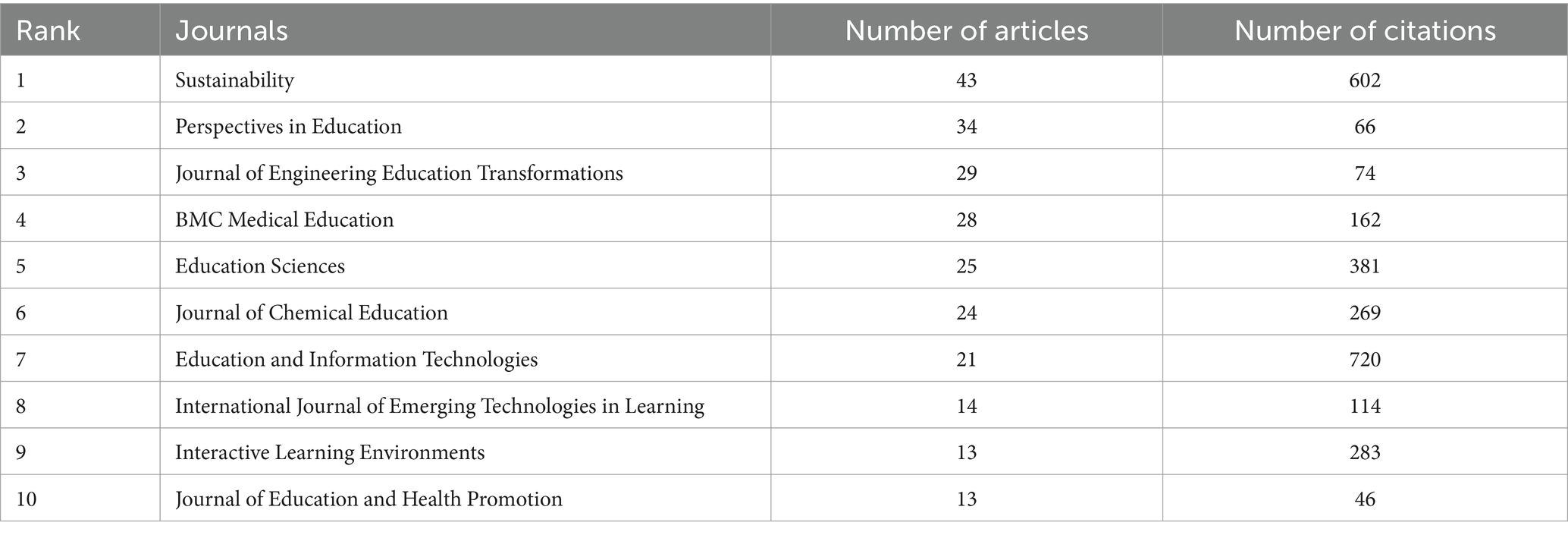
Table 3. The top 10 peer-reviewed journals published articles on online education in higher education in BRICS countries.
Most influential authors
Table 4 presents the most influential authors who published online learning in higher education from the related countries. The results showed that Welsen is the author who published the highest number of articles, with five articles. The following authors, Bozkurt, Kandakatla, Mudau, Vijayalakshmi, and Yang, have four articles. Andrews, Ashraf, Aslam, and Bello follow these authors. Ashraf and Bozkurt are the two authors who have the most citations in the SCOPUS database.
We conducted a co-authorship analysis and involved the collaborations among the authors. We detected the authors who had published at least three articles in the dataset for this aim. The results from the co-authorship showed that there are a few collaborations among the authors from BRICS countries. The results revealed 34 authors in 28 clusters. Although these authors had three articles regarding online learning, the results showed the existence of slight collaborations. Only a few authors co-authored the articles that were published. For example, Fouche and Adrews co-authored (red cluster, see Figure 4). The others are Bolaji and Bello (green cluster), Hasan and Mukherjee (yellow cluster), and Xinmeng and Yajuan (purple cluster). Figure 4 shows clusters of authors who work collaboratively on common literature emphasis areas.
Most influential documents
The results from Table 5 show that the studies by Dhawan (2020), Mishra et al. (2020), and Tumwesige (2020) are the first three. Based on these results, it can be concluded that these authors influenced the research on online learning in higher education. These researchers are followed by Fornell and Larcker (1981), Braun and Clarke (2006), Hodges et al. (2020), Pokhrel and Chhetri (2021), Venkatesh et al. (2003), Ali (2020), and Davis (1989). Notably, the study of Fornell and Larcker (1981) is not from a different area than the education area but received the highest citations on online learning research. From the results in Table 5, another finding is that the studies are published in journals focused on education, except for the Journal of Marketing Research.
Research trends
We identified the keywords in research on online learning and higher education in BRICS countries. In this analysis, we searched the keywords used by researchers more than 20 times. The results from the keyword co-occurrence analysis are given in Figure 5. The results show the relationships among keywords. Also, these relationships present an idea regarding the patterns in the research on online learning in higher education in the related countries. The different colors in Figure 5 reveal the research clusters and provide evidence to determine research trends in online learning. The results revealed that e-learning, online learning, students, and teaching are central in the red cluster. Also, blended learning, online education, surveys, teaching-learning, learning systems, education computing, engineering education, computer-aided instruction, distance education and student engagement, and remote learning are around the red cluster. In the green cluster, COVID-19, the pandemic, learning, online education, and students are at the center. In addition, medical education, education, human, humans, medical students, cross-sectional study, education distance, distance learning, curriculum, India, China, and the internet are around the green cluster.
Discussion
This paper presents research trends examining online learning in higher education in BRICS countries after COVID-19. The results of the number of documents showed that there has been an increase in the amount of research on online learning in higher education. The results revealed that the highest number of publications was conducted in 2022. Our findings about this trend in the number of publications support the results of Aristovnik et al. (2023), Brika et al. (2022), Fauzi (2022), Küçük-Avci et al. (2022), and Zhang et al. (2022). For example, Küçük-Avci et al. (2022) concluded that the COVID-19 pandemic impacted higher education, increasing interest in e-learning and online learning in the post-pandemic period. As a result, the COVID-19 pandemic has significantly impacted students, instructors, and educational institutions worldwide, leading to a rapid shift to online learning modalities (Adnan, 2020; Almazova et al., 2020; del Arco et al., 2021). Due to the pandemic, this sudden transition to online education has necessitated a thorough assessment of the benefits, limitations, and recommendations for the effectiveness of online learning (Almazova et al., 2020; Mukhtar et al., 2020). Furthermore, the disruption caused by the pandemic has led to a global reassessment of online education in higher education (Wang et al., 2022). This shift has necessitated research into higher education students’ readiness for online learning and the effectiveness of online education platforms (Almazova et al., 2020; Chung et al., 2020). The pandemic has forced educators to adapt to online forms of teaching and learning quickly, leading to increased research on the challenges and opportunities of distance learning during emergencies (Alasmari, 2021; del Arco et al., 2021; Lee et al., 2021). Thus, the COVID-19 pandemic has accelerated the adoption of online learning in higher education, which has led to a surge in research to understand the impact, effectiveness, challenges, and opportunities associated with this shift (Moorhouse and Kohnke, 2021). Thus, the need to assess the impact of online learning during and after the pandemic has led researchers to investigate various aspects of online education to improve teaching and learning practices in higher education (Ramos-Pla et al., 2021).
The results showed that researchers from China and South Africa had the highest publications on online learning among BRICS countries. However, researchers in Russia had very few publications. This result is similar to those of Tlili et al. (2022). They found an increased trend in the countries contributing to Massive Open Online Courses research. They found that researchers from China and Spain showed more interest in MOOC research. In addition, this result is partly similar to those of Zhang et al. (2022), who have similar findings. Researchers from 103 countries worldwide examined diverse topics related to pandemic-induced online learning in the context of higher education. The results regarding the relationships of co-authorship among the BRICS countries revealed specific relationships of scholars with their colleagues from other countries that are not placed among BRICS countries. Only scholars from Indian and South African researchers collaborated closely. One reason for this result may be that the positive change in the production of scientific publications in South Africa reflects the willingness of the international community to collaborate with South African researchers (Sooryamoorthy, 2013). This openness to collaboration among South African researchers creates a favorable atmosphere for Indian and South African researchers to engage in joint online learning projects. Furthermore, the existing culture of collaboration among South African researchers and the positive reception of international collaborations and partnerships in various fields provides a solid foundation for Indian and South African researchers to build close collaboration in online learning.
Another finding is that the results also show that Russian researchers did not have any collaborations with other countries. Various factors can make collaboration between Russian researchers and their colleagues difficult. As Hall et al. (2018) have noted, collaboration between scientists with overlapping areas of expertise can be difficult due to competition for resources. However, scientists with little overlap may have difficulty communicating effectively and aligning their goals. Another reason could be that the historical legacies and organizational challenges within the Russian science system, as discussed by Karaulova et al. (2016) and Oleksiyenko (2021), may also influence the dynamics of collaboration. These issues, combined with the individualistic nature of the research system, may contribute to Russian researchers’ hesitation or challenges when engaging in collaborations.
The results about the most influential journals revealed that the Sustainability journal published more articles on online learning in higher education. The following journals are Perspectives in Education and Journal of Engineering Education Transformations. On the other hand, the results of the citations showed that Education and Information Technologies is the journal with the highest number of citations in the SCOPUS database. The following journal is a Sustainability journal. These results show that the peer-reviewed journals that have published articles for a long time may have the most published articles and citations. Additionally, high-quality research can attract more citations (Bornmann and Leydesdorff, 2017). In addition, articles published in high-ranking journals are more likely to be cited and thus contribute to the total number of citations in the journal (Kim et al., 2019). In particular, high-ranking journals attract more citations due to their trust and credibility. The journal’s relevance and academic focus also affect citation rates, with publications with a strong academic focus receiving more citations. High citation rates in peer-reviewed journals can be attributed to factors such as the quality of the research, the journal’s reputation, editorial integrity, and the relevance of the content in citation rates.
Our results regarding co-authorship analysis who worked in BRICS countries revealed a few collaborations among the researchers from BRICS countries. The results demonstrated slight collaborations among scholars in BRICS countries. The results regarding the most influential documents from co-citation analysis showed that the studies by Dhawan (2020), Mishra et al. (2020), and Tumwesige (2020) are cited by researchers who worked on online learning in higher education. The results of research trends revealed two lines of research. The first line of research has focused on e-learning, online learning, students, and teaching, which are central to the red cluster. Also, blended learning, online education, surveys, teaching-learning, learning systems, education computing, engineering education, computer-aided instruction, distance education and student engagement, and remote learning are around the red cluster. In the green cluster, COVID-19, the pandemic, learning, online education, and students are at the center. In addition, medical education, education, human, humans, medical students, cross-sectional study, education distance, distance learning, curriculum, India, China, and the internet are around the green cluster.
Conclusion
This paper aims to analyze current research trends on online learning in higher education in BRICS countries post-COVID-19. The COVID-19 pandemic has led to considerable disruption in higher education and accelerated the integration of online learning tools into the education process. Despite the easing of the pandemic, the online learning methods that emerged during this time are still relevant and useful for future education. This bibliometric analysis thoroughly summarizes research on online learning in higher education in the BRICS countries. The study has added to the existing research knowledge in several ways. First, it provides an overview of the educational adjustments made in response to the pandemic, highlighting the flexible shift to virtual platforms and the role of technology in maintaining educational continuity. Secondly, the study describes the research approaches used by scholars in BRICS countries. The study provides a detailed summary of a well-defined and all-encompassing structure for online higher education research in the BRICS countries. It also examines the development of online education and research patterns over the last 4 years. It reveals a significant increase in online course offerings, digital literacy initiatives, and cross-institutional collaboration to improve the quality of online education. The findings provide researchers with a basis for recognizing the current state of research and identifying any shortcomings of previous studies. It highlights areas for further investigation, such as the impact of online learning on student engagement and outcomes, the effectiveness of different instructional designs, and the long-term sustainability of online programs. In addition, the study highlights the need for continued research to monitor the development of online education and its impact on the global educational landscape, particularly in developing countries with growing internet penetration and digital infrastructure.
Recommendations
The bibliometric study offers potential pathways for future research. Future bibliometric studies should focus on conducting detailed analyses of the areas that have shown significant relevance for online learning post-pandemic. This will help utilize innovative and technological tools for higher education teaching, student well-being, and professional development. An in-depth analysis of these areas could provide valuable insights into the respective future areas to improve researchers’ understanding of the impact of online learning post-pandemic. Additionally, content analysis may provide a more detailed understanding of scientific discourse by exploring topics and contexts in bibliometric studies. Moreover, conducting future analyses and comparisons would be beneficial in exploring the differences between countries with different social and educational contexts. Such an analysis can reveal different and similar patterns based on the educational contexts of different groups of countries concerning online learning amidst the pandemic. Collaboration and information sharing between countries can be improved by analyzing their differences. This could be further enriched by including multidisciplinary perspectives, including psychological, sociological, and technological viewpoints, to create a comprehensive framework that reflects the multi-faceted nature of online learning. Interdisciplinary collaboration could also uncover new dimensions of online education that have not yet been adequately explored, such as the impact of cultural nuances on the acceptance and effectiveness of online learning tools.
Longitudinal studies could also help understand the development of online learning trends. These studies would track changes over time and provide a dynamic view of online education’s development and long-term outcomes. Such longitudinal research could also identify which educational practices introduced during the pandemic have become integral to the educational landscape. In conclusion, future bibliometric studies should not only seek to capture existing research but also identify gaps and emerging trends. This could guide policymakers, educators, and researchers in navigating the post-pandemic education field. The insights gained from these studies could guide the development of robust, inclusive, and effective online learning environments tailored to a global student population with diverse needs and backgrounds in higher education. The COVID-19 pandemic has led to significant changes in higher education. Nevertheless, it has also sped up the integration of online learning tools in education. The online learning methods created during the pandemic remain pertinent and beneficial for future education. Hence, researchers and institutions should try to enhance student engagement in online learning to be flexible to changing student requirements.
Limitations
It is worth noting that only articles from journals listed in the Scopus database were considered in this study. Other databases, such as ProQuest, Science Direct, and Web of Science, could be used in future studies to obtain a more comprehensive analysis. Furthermore, the bibliometric analysis has certain limitations as it only considers metadata and not the actual content of the documents. The content analysis could address this limitation in future bibliometric studies. One of our study’s limitations could be the authors’ judgment in determining the keywords for this study. To overcome this limitation, we attempted to include all related keywords to online learning, higher education, and COVID-19 to ensure a broad coverage of relevant literature. Furthermore, an algorithmic approach to keyword selection could be developed to improve objectivity and reproducibility. There may have been a limited number of keywords in some publications, making it difficult to accurately interpret the article’s content when examining the co-occurrence of keywords. This could be mitigated in future research by using advanced text mining and natural language processing techniques to extract topics even when no explicit keywords are given.
Author contributions
AM: Writing – review & editing, Writing – original draft. NO: Writing – review & editing, Writing – original draft. VP: Writing – review & editing, Writing – original draft. YB: Writing – review & editing, Writing – original draft. GZ: Writing – review & editing, Writing – original draft. VC: Writing – review & editing, Writing – original draft.
Funding
The author(s) declare that no financial support was received for the research, authorship, and/or publication of this article.
Conflict of interest
The authors declare that the research was conducted in the absence of any commercial or financial relationships that could be construed as a potential conflict of interest.
Publisher's note
All claims expressed in this article are solely those of the authors and do not necessarily represent those of their affiliated organizations, or those of the publisher, the editors and the reviewers. Any product that may be evaluated in this article, or claim that may be made by its manufacturer, is not guaranteed or endorsed by the publisher.
References
Adnan, M. (2020). Online learning amid the COVID-19 pandemic: students perspectives. Int. J. Educ. Psychol. 1, 45–51. doi: 10.33902/jpsp.2020261309
Alasmari, T. (2021). Learning in the COVID-19 era: higher education students and faculty’s experience with emergency distance education. Int. J. Emerg. Technol. Learn. 16:40. doi: 10.3991/ijet.v16i09.20711
Ali, W. (2020). Online and remote learning in higher education institutes: A necessity in light of COVID-19 pandemic. High. Educ. Stud. 10:16. doi: 10.5539/hes.v10n3p16
Almazova, N., Krylova, E., Rubtsova, A., and Odinokaya, M. (2020). Challenges and opportunities for Russian higher education amid COVID-19: teachers’ perspective. Educ. Sci. 10:368. doi: 10.3390/educsci10120368
Ardissone, A., Galindo, S., Triplett, E., and Drew, J. (2023). Online and on-campus transfer students experienced different impacts from the pandemic. Front. Educ. 8:1067380. doi: 10.3389/feduc.2023.1067380
Aristovnik, A., Karampelas, K., Umek, L., and Ravšelj, D. (2023). Impact of the COVID-19 pandemic on online learning in higher education: A bibliometric analysis. Front. Educ. 8:1225834. doi: 10.3389/feduc.2023.1225834
Bates, T. (2023). Key issues in teaching and learning resulting from the COVID-19 pandemic. J. Nat. Res. Life Sci. Educ. 52:e20118. doi: 10.1002/nse2.20118
Besser, A., and Zeigler-Hill, V. (2022). Adaptability to a sudden transition to online learning during the COVID-19 pandemic: understanding the challenges for students. Scholarsh. Teach. Learn. Psychol. 8, 85–105. doi: 10.1037/stl0000198
Bilal, H., Akbar, A., Yasmin, F., Rahman, A. U., and Li, S. (2022). Virtual learning during the COVID-19 pandemic: A bibliometric review and future research agenda. Risk Manag. Healthc. Policy 15, 1353–1368. doi: 10.2147/rmhp.s355895
Bornmann, L., and Leydesdorff, L. (2017). Skewness of citation impact data and covariates of citation distributions: A large-scale empirical analysis based on web of science data. J. Informet. 11, 164–175. doi: 10.1016/j.joi.2016.12.001
Bornmann, L., Wagner, C., and Leydesdorff, L. (2015). BRICS countries and scientific excellence: A bibliometric analysis of most frequently cited papers. J. Assoc. Inf. Sci. Technol. 66, 1507–1513. doi: 10.1002/asi.23333
Braun, V., and Clarke, V. (2006). Using thematic analysis in psychology. Qual. Res. Psychol. 3, 77–101. doi: 10.1191/1478088706qp063oa
Brika, S. K. M., Chergui, K., Algamdi, A., Musa, A. A., and Zouaghi, R. (2022). E-learning research trends in higher education in light of COVID-19: A bibliometric analysis. Front. Psychol. 12:762819. doi: 10.3389/fpsyg.2021.762819
Chung, E., Subramaniam, G., and Dass, L. (2020). Online learning readiness among university students in Malaysia amidst COVID-19. Asian J. Univ. Educ. 16:45. doi: 10.24191/ajue.v16i2.10294
Davis, F. D. (1989). Perceived usefulness, perceived ease of use, and user acceptance of information technology. MIS Q. 13:319. doi: 10.2307/249008
del Arco, I., Flores, S., and Ramos-Pla, A. (2021). Structural model to determine the factors that affect the quality of emergency teaching, according to the perception of the student of the first university courses. Sustain. For. 13:2945. doi: 10.3390/su13052945
Dhawan, S. (2020). Online learning: A panacea in the time of COVID-19 crisis. J. Educ. Technol. Syst. 49, 5–22. doi: 10.1177/0047239520934018
Fauzi, M. A. (2022). E-learning in higher education institutions during COVID-19 pandemic: current and future trends through bibliometric analysis. Heliyon 8:e09433. doi: 10.1016/j.heliyon.2022.e09433
Fornell, C., and Larcker, D. F. (1981). Evaluating structural equation models with unobservable variables and measurement error. J. Mark. Res. 18, 39–50. doi: 10.1177/002224378101800104
Greyling, S. C., Mollo, N. T., Neethling, M., Preston, L. D., Steyn, H. J., Taylor, B., et al. (2022). Education for sustainable development in BRICS: zoom on higher education. BRICS Educ. doi: 10.4102/aosis.2022.bk277
Guppy, N., Verpoorten, D., Boud, D., Lin-Lipsmeyer, L., Tai, J., and Bartolic, S. (2022). The post-covid-19 future of digital learning in higher education: views from educators, students, and other professionals in six countries. Br. J. Educ. Technol. 53, 1750–1765. doi: 10.1111/bjet.13212
Hafeez, M., Naureen, S., and Sultan, S. (2022). Quality indicators and models for online learning quality assurance in higher education. Electron. J. e-Learn. 20, pp374–pp385. doi: 10.34190/ejel.20.4.2553
Hall, K., Vogel, A., Huang, G., Serrano, K., Rice, E., Tsakraklides, S., et al. (2018). The science of team science: A review of the empirical evidence and research gaps on collaboration in science. Am. Psychol. 73, 532–548. doi: 10.1037/amp0000319
Hamad, F. (2021). Palestinian mothers’ perceptions about online learning at public and private elementary schools during COVID-19: challenges and recommendations. Pedagogical Res. 6:em0098. doi: 10.29333/pr/11009
Hodges, C. B., Moore, S., Lockee, B. B., Trust, T., and Bond, M. A. (2020). The difference between emergency remote teaching and online learning. Educ. Rev., 1–12. Available at: https://er.educause.edu/articles/2020/3/the-difference-between-emergency-remote-teaching-and-online-learning
Karaulova, M., Gök, A., Shackleton, O., and Shapira, P. (2016). Science system path-dependencies and their influences: nanotechnology research in Russia. Scientometrics 107, 645–670. doi: 10.1007/s11192-016-1916-3
Khomyakov, M., Dwyer, T., and Weller, W. (2020). Internationalization of higher education: excellence or network building? What do brics countries need most? Sociologias 22, 120–143. doi: 10.1590/15174522-99066
Kim, L., Portenoy, J., West, J., and Stovel, K. (2019). Scientific journals still matter in the era of academic search engines and preprint archives. J. Assoc. Inf. Sci. Technol. 71, 1218–1226. doi: 10.1002/asi.24326
Koh, J., Daniel, B., and Greenman, A. (2023). Adaptiveness for online learning: Conceptualising ‘online learning dexterity’ from higher education students’ experiences. N. Z. J. Educ. Stud. 58, 379–397. doi: 10.1007/s40841-023-00287-2
Kozak, A., Blyznyuk, L., Knysh, T., Ivanashko, O., and Honchar, K. (2023). Online learning as a tool for the education system in the context of digitalisation. J. Curric. Stud. 12:132. doi: 10.5430/jct.v12n2p132
Küçük-Avci, I., Topal, M., and İstanbullu, A. (2022). The effects of the COVID-19 pandemic on distance education in higher education: A bibliometric analysis study. Croatian J. Educ. 24, 457–488. doi: 10.15516/cje.v24i2.4534
Kumar, R., and Fernandez, D. (2022). Impact of challenges and advantages of online learning on the academic performance of students in higher education institution in Sultanate of oman. Asian J. Soc. Sci. Stud. 36-50, 36–50. doi: 10.9734/ajess/2022/v26i130614
Lee, K., Fanguy, M., Bligh, B., and Lu, X. S. (2021). Adoption of online teaching during the COVID-19 pandemic: A systematic analysis of changes in university teaching activity. Educ. Rev. 74, 460–483. doi: 10.1080/00131911.2021.1978401
Li, X., and Pei, Z. (2023). Improving effectiveness of online learning for higher education students during the COVID-19 pandemic. Front. Psychol. 13:1111028. doi: 10.3389/fpsyg.2022.1111028
Mazurek, E. (2022). Higher education during the COVID-19 pandemic in the opinions of students in Poland. Tuning J. High. Educ. 10, 263–284. doi: 10.18543/tjhe.2172
Mishra, L., Gupta, T., and Shree, A. (2020). Online teaching-learning in higher education during lockdown period of COVID-19 pandemic. Int. J. Educ. Res. Open 1:100012. doi: 10.1016/j.ijedro.2020.100012
Moorhouse, B. L., and Kohnke, L. (2021). Thriving or surviving emergency remote teaching necessitated by COVID-19: university teachers’ perspectives. Asia Pac. Educ. Res. 30, 279–287. doi: 10.1007/s40299-021-00567-9
Morton, W., and Durandt, R. (2023). Learning first-year mathematics fully online: were students prepared, how did they respond? EURASIA J. Math., Sci Tech. Ed. 19:em2272. doi: 10.29333/ejmste/13189
Mukhtar, K., Javed, K., Arooj, M., and Sethi, A. (2020). Advantages, limitations and recommendations for online learning during covid-19 pandemic era. Pak. J. Med. Sci. 36, S27–S31. doi: 10.12669/pjms.36.covid19-s4.2785
Mustapha, I., Van, N., Shahverdi, M., Qureshi, M., and Khan, N. (2021). Effectiveness of digital technology in education during covid-19 pandemic. A bibliometric analysis. Int. J. Interact. Mob. Technol. 15:136. doi: 10.3991/ijim.v15i08.20415
Oleksiyenko, A. (2021). World-class universities and the soviet legacies of administration: integrity dilemmas in Russian higher education. High. Educ. Q. 76, 385–398. doi: 10.1111/hequ.12306
Ozdamli, F., and Karagozlu, D. (2022). Online education during the pandemic: A systematic literature review. Int. J. Emerg. Technol. Learn. 17, 167–193. doi: 10.3991/ijet.v17i16.32287
Page, M. J., McKenzie, J. E., Bossuyt, P. M., Boutron, I., Hoffmann, T. C., Mulrow, C. D., et al. (2021). The PRISMA 2020 statement: an updated guideline for reporting systematic reviews. BMJ 372:n71. doi: 10.1136/bmj.n71
Pokhrel, S., and Chhetri, R. (2021). A literature review on impact of COVID-19 pandemic on teaching and learning. High. Educ. Future 8, 133–141. doi: 10.1177/2347631120983481
Rababah, A., Nikitina, N., Гребенникова, В., Gardanova, Z., Zekiy, A., Ponkratov, V., et al. (2021). University social responsibility during the covid-19 pandemic: universities’ case in the BRICS countries. Sustain. For. 13:7035. doi: 10.3390/su13137035
Ramos-Pla, A., del Arco, I., and Flores Alarcia, S. (2021). University professor training in times of Covid-19: analysis of training programs and perception of impact on teaching practices. Educ. Sci. 11:684. doi: 10.3390/educsci11110684
Ricardo, C., Vieira, C., Quintero-Manes, R., and Cano, J. (2023). Online or remote education? Preferences of Colombian higher education students. Contemporary. Educ. Technol. 15:ep465. doi: 10.30935/cedtech/13606
Riddell, J., Gadoury-Sansfaçon, G., and Stoddard, S. (2021). Building institutional capacities for students as partners in the design of COVID classrooms. Int. J. Stud. Partners 5, 111–122. doi: 10.15173/ijsap.v5i2.4603
Rodrigues, J. (2018). Bric’s education challenge to economic development. J. Educ. Soc. Policy 5:n3p10. doi: 10.30845/jesp.v5n3p10
Sartika, S., and Nirbita, B. (2023). Academic resilience and students engagement in higher education: study on post-pandemic behaviour. Edu. Sci. J. 4, 29–34. doi: 10.30598/edusciencesvol4iss1pp29-34
Shahzad, A., Hassan, R., Aremu, A., Hussain, A., and Lodhi, R. (2020). Effects of COVID-19 in e-learning on higher education institution students: the group comparison between male and female. Qual. Quant. 55, 805–826. doi: 10.1007/s11135-020-01028-z
Sim, S., Sim, H., and Quah, C. (2021). Online learning: A post-covid-19 alternative pedagogy for university students. Asian J. Univ. Educ. 16:137. doi: 10.24191/ajue.v16i4.11963
Sooryamoorthy, R. (2013). Scientific research in the natural sciences in South Africa: A scientometric study. S. Afr. J. Sci. 109:11. doi: 10.1590/sajs.2013/20120001
Stevanović, A., Božić, R., and Radović, S. (2021). Higher education students' experiences and opinion about distance learning during the covid-19 pandemic. J. Comput. Assist. Learn. 37, 1682–1693. doi: 10.1111/jcal.12613
Tlili, A., Altinay, F., Altinay, Z., Aydin, C. H., Huang, R., and Sharma, R. (2022). Reflections on massive open online courses (MOOCs) during the COVID-19 pandemic: A bibliometric mapping analysis. Turk. Online J. Dist. Educ. 23, 1–17. doi: 10.17718/tojde.1137107
Tumwesige, J. (2020). COVID-19 educational disruption and response: Rethinking e-learning in Uganda. Cambridge: University of Cambridge.
Turnbull, D., Chugh, R., and Luck, J. (2021). Transitioning to e-learning during the COVID-19 pandemic: how have higher education institutions responded to the challenge? Educ. Inf. Technol. 26, 6401–6419. doi: 10.1007/s10639-021-10633-w
Venkatesh, V., Morris, M. G., Davis, G. B., and Davis, F. D. (2003). User acceptance of information technology: toward a unified view. MIS Q. 27:425. doi: 10.2307/30036540
Vyas-Doorgapersad, S. (2022). The role of BRICS in global governance to promote economic development. Afr. Public Serv. Deliv. Perform. Rev. 10, 633. doi: 10.4102/apsdpr.v10i1.633
Wang, H., Wu, J., Muhedaner, M., and Maihemuti, S. (2022). College students online education evaluation through swot analysis during covid-19. Ieee Access 10, 88371–88385. doi: 10.1109/access.2022.3198082
Yang, D., Tang, Y., Hayashi, R., Ra, S., and Lim, C. (2022). Supporting inclusive online higher education in developing countries: lessons learnt from Sri Lanka’s university closure. Educ. Sci. 12:494. doi: 10.3390/educsci12070494
Zhang, L., Carter, R. A., Qian, X., Yang, S., Rujimora, J., and Wen, S. (2022). Academia’s responses to crisis: A bibliometric analysis of literature on online learning in higher education during COVID-19. Br. J. Educ. Technol. 53, 620–646. doi: 10.1111/bjet.13191
Zhang, W., and Wu, Q. (2022). A case study of military vocational online education during the post-COVID-19 era. Int. J. Educ. Hum. Soc. Sci. 5, 249–252. doi: 10.54097/ijeh.v5i2.2179
Zhu, Q. (2021). The future of higher education online learning. Glob. J. Eng. Res. 7, 1–3. doi: 10.33552/gjes.2021.07.000664
Keywords: online learning, higher education, BRICS countries, bibliometric, distance education
Citation: Masalimova AR, Orekhovskaya NA, Pivovarov VA, Borovikova YV, Zhirkova GP and Chauzova VA (2024) Analyzing trends in online learning in higher education in the BRICS countries through bibliometric data. Front. Educ. 9:1409013. doi: 10.3389/feduc.2024.1409013
Edited by:
Filipa Seabra, Universidade Aberta, PortugalReviewed by:
Susana Henriques, Universidade Aberta (UAb), PortugalAnabel Ramos-Pla, University of Lleida, Spain
Copyright © 2024 Masalimova, Orekhovskaya, Pivovarov, Borovikova, Zhirkova and Chauzova. This is an open-access article distributed under the terms of the Creative Commons Attribution License (CC BY). The use, distribution or reproduction in other forums is permitted, provided the original author(s) and the copyright owner(s) are credited and that the original publication in this journal is cited, in accordance with accepted academic practice. No use, distribution or reproduction is permitted which does not comply with these terms.
*Correspondence: Alfiya R. Masalimova, YWxma2F6YW5AbWFpbC5ydQ==
 Alfiya R. Masalimova
Alfiya R. Masalimova Natalia A. Orekhovskaya2
Natalia A. Orekhovskaya2